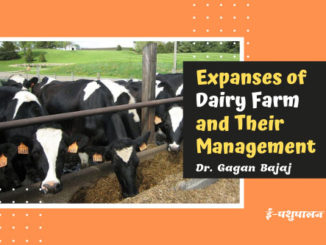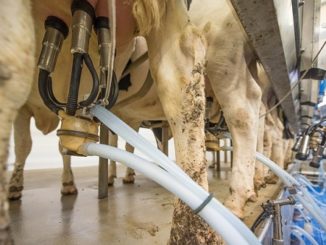Calf management
- Remove the mucous from nose and mouth of the calf immediately after birth and allow the mother to lick the calf which helps to dry off the calf and helps to stimulate breathing and circulation. If not licked by the mother, then dry with cloth or jute gunny bags or dried straw.
- Provide artificial respiration by compression and relaxing the chest with hands
- Hold the hind legs up and forelegs down of calf to allow the flow of the mucus from the nose and mouth and make free respiration
- The umbilical cord should be tied with sterilized cotton thread at about 2 to 2.5 inches away from the body and make a cut 1cm below the ligature and apply tincture Iodine or boric acid or any other antiseptics.
- The shed and bedding materials should be dry and clean and allow free air movement
- The udder and teats should be washed properly with potassium permanganate or chlorine solution and dry.
- Allow the calf to suckle the first milk of the mother cow (Colostrum) as it contains immunoglobulin, provide immunity to the calf upto development of own immunity. The colostrum should be given for at least first 3 days. It contains higher proportions of vitamin A and proteins. Colostrum also contains antitrypsin which avoids digestion of immunoglobulins in the stomach and is absorbed it is.
- Normally the calf will stand and attempt to suckle the colostrum within one hour, if not suitable assistance should be given to the weak calves.
- Birth weight of the calf should be recorded immediately after birth
- Feed milk twice a day or three times for weak calves
- Feed the milk as 10% of calf’s body weight or maximum of 5-6 litres/day. Milk feeding should be continued for 6-8 weeks. Excess feeding induces calf scours
- Feed the calf starter at one month of age
- Feed green fodder of good quality and hay from 4th month onward
- Identification the calf by tattooing and tagging or branding after one year of calf
- Dehorning should be done within 7-10 days after birth with use of caustic soda or red hot iron or electrical method
- Deworming should be done at regular interval of 30 days with suitable deworming drug
- Vaccination should be done as per the advice by the local veterinary department
- Clean, boiled drinking water should be provided to the calf from 2-3 weeks onwards
- The calves should be separated and placed in groups after 3 months afterwards and at 6 months onwards the female and male calves should be separated and housed
- Death of calves was observed in first month is due to pneumonia, diarrhoea and worm infestation. Therefore, house of these calves should be clean and worm condition to avoid these problems
- Supernumerary teats should be removed within 2 months of age
- The male calves should be castrated with 8-10 weeks of age
- The calves should be cleaned and dried to avoid fungal infections
- Mineral mixture or mineral blocks should be provided to avoid mineral deficiency

Heifer management
- Today calves are tomorrow cows. Therefore the heifer should be maintained with better care and management, which will become high quality replacement stock to the dairy farm.
- Sufficient feed should be provided to achieve sufficient growth and body weight as body weight is more important to attain the puberty and sexual maturity. Significantly higher amount of protein is needed during growing stage than the energy. The growth and body weight depend on the quality of feed, forage are fed to the heifers. Breeding the heifer at under sized or under weight is never profitable. Small heifers are suffered more likely to dystocia. Aged heifers will give more milk in the first lactation, but the reproductive age and whole life milk production is considerably reduced than the heifer which starts milking at earlier stage. Therefore proper management of heifer will yield higher milk.
- Loose housing system with open shelter at the one side is good for heifer management. The heifer shed should be dry and should be constructed in such a way that the air flow and sun light should be sufficient and should be protected from drafts.
- Heat signs are increased motor activity, decreased feed intake, bellowing and switch the tail to one side, mounting to other cows, standing heat (cow stand to be mounted by other cow or bull), clear, glissening mucus discharge from vagina, redness and swelling of vulva.
- The pregnant heifer should be placed in separate shed at about 6-8 weeks before parturition
- The pregnant heifers should be provided at least 2-3 kg concentrate mixture daily and sufficient good quality forages.
- The pregnant calves should be treated very gently and avoid distress to the heifers as if stress is increased leads to premature birth or abortion.
- Health and growth of the heifers are very important to get quality calves. All the heifers should be maintained by hygienic housing, well balanced nutritious feeding and preventive treatment against common diseases.
- The records should be maintained properly and checked periodically for growth and improvement. If any calves suffered any problem, immediately take action to rectify those problems or if not possible to correct, remove from the herd.
- The calving in the heifer is first time and the animal may suffer difficulty, so extra care should be taken during the parturition time.
Management of milking cows
- The milking cows should be properly fed and manage to get highest milk production.
- Green succulent forage with leguminous hay or straw should be provided upto the cow can consume. Concentrate should be provided at the rate 1 kg for every 2-2.5 litres of milk. Salt and mineral mixture should be provided sufficient quantity and quality throughout the lactation.
- The milking cows should be treated with very gentle and kindness as the excitement or frightens leads to release of cortisol which inturn reduce the milk production and secretion.
- After delivery, the some cow will come to heat within 30-50 day in proper feeding and care. Conception rate is around 50%. But do not do breeding. Shorter calving to calving interval is increasing the profitability of the dairy farm and such animals are good milk producer. This can be achieved by proper maintain the records of breeding and calving of the animals in the farm which will ensure the milk flow throughout the year.
- Each and individual cows should be given attention on feed and other management according to the production, for this purpose, individual production records need to be maintained.
- Feeding method and time should be regularly followed. Concentrate feed should be fed just before or during milking time and roughage should be fed after milking.
- Water should be available ad libitum and easily accessible.
- Milking practices should be done at regular time and milk should be collected as much as possible. The milk secretion in the udder depends on the frequent collection and quantity of milk collected. Incomplete milking causes reduced the milk secretion or production. Then milk yield will be reduced. Milking trice is better than twice as trice will increase 10-15% milk yield.
- Rapid, continuous and dry hand milking should be practiced and complete milking should be practiced. Whole hand milking method is better than thumb and index finger milking.
- The cows should be practiced to drain the milk without calf sucking, which will enhance the clean milk production, will wean the calf and higher milk production
- Loose housing system with shelter should be provided during the hot summer season or hotter time. The milking cows will get sufficient exercise in loose housing system, which inturn enhance milk production.
- Washing and grooming the dairy cows should be done before milking which will enhance the clean milk production. Daily grooming and brushing not only remove the loose hair, dirt and parasite from the skin but also enhance blood circulation, milk production and shininess of the skin coat.
- Common diseases or health problems should be checked, diagnosed and treated proper in day to day practices.
- Vaccination and deworming should be done in periodical manner with the advice from the local Veterinarian.
- Common vices like kicking, licking, suckling should be properly detected and treated.
- Dry period between calving should be at least 60-90 days provided. Insufficient dry period leads to reduction of milk yield in subsequent lactation.
- Each and every animal should be numbered and information such as calving dates, milk yield, fat percentage, feed taken, breeding status, pregnancy status should be maintained.
- All the milking animals should be checked for mastitis at regular interval.
Management of Pregnant cows
- Good care and managemental practices should be followed to pregnant animals which will help to improve the milk production in subsequent lactation
- Extra concentrate mixture should be provided at 1.25 to 1.75 kg and provide good quality leguminous fodder
- Should not provide excessive amount of feed or fodder or concentrate mixture to the pregnant cows which causes the cows become fatty leads to difficulty in birth or dystocia. At the same time, if not provide sufficient feed leads to poor growth pregnant cows and its fetus.
- Ad libitum potable clean drinking water should be provided and the pregnant cows should be protected from the heat thermal stress
- The pregnant should be separated from other animals especially with aborted animals which are infected with diseases like brucellosis. Similarly the pregnant animals should be separated from bulls, calves, dry animals.
- Loose housing system is suitable for pregnant animal as it gets some mild to moderate exercise, which helps to improve the calving process and will avoid any calving difficulty.
- Pregnant animals should be housed in the separate shed, do not allow them to fight with other animals and should not allow to chase by dogs or any other animals
- Pregnant cows should be maintained in plain areas and should not be maintained in undulated areas, slippery floor, if animal is to fall will leads to fracture, dislocation or deformity in the cows.
- Avoid narrow doors, crowding during movement and slopping floor
- Breeding should be maintained very correctly, which will be very useful to calculate the expected delivery date. The pregnant animals need to be separated in individual parturition shed at least 1-2 weeks before parturition. The parturition pen should be thoroughly cleaned, sterilized and fresh bedding materials may be provided and free from noise or any other disturbances.
- Extra concentrate mixture at about 1 kg during the last 8 weeks of pregnancy
- Feed laxative should be provided 3-5 days before and after delivery
- Symptoms of parturition such as swelling of external genitalia, swelling of udder should be noted. Majority of cows delver the calf without any difficulty, if there is any problem, call the veterinarian for assistance.
- Pregnancy period is about 280-290 (9 months + 15 days)
- If the cow is giving milk, the cow should be dried off 40-60 days before calving
- Pregnancy can be confirmed by observing the behavioural signs such as cessation of heat, change in temperament from vicious to docile, marked improve of body condition, enlarged mammary gland especially at the end.
- Quickening: give the cold water at morning and examine the movement of live fetus in right flank (uterus)
- With approach of delivery: increase size of udder and abdomen, wax secretion (bead like) in udder at last few days, swelling of vulva and relaxation of pelvic ligament
- After delivery, the external genitalia, flank, udder should be cleaned thoroughly with warm mild antiseptic solution
- The placenta will leave the cow within 2-4 hours after calving, if not more than 8 hours, call veterinarian for treatment. In general at difficult birth manual interference should be done by the veterinarian.
- Give the cow clean warm water to compensate the fluid losses in calving, give the cow easily digested food and laxative (bran mash), increase amount of concentrate gradually till full dosage after 3 days
- The animals are normally suffering milk fever (calcium deficiency) during or immediately after delivery, therefore calcium supplement is essential
- External genitalia, buttocks and around udder should be washed with warm water and antiseptic (KMno4)
- Sometimes severe edema is observed in the udder or just in front of the udder, in such animals, milk collection should be done partially for some initial periods
- Squeezing the first milk from the udder before suckling to get rid any micro organism
- Keep the cow with and calf in the calving pen for few days to enhance maternal filial bond









Be the first to comment